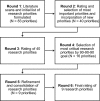Research priorities to inform "Treat All" policy implementation for people living with HIV in sub-Saharan Africa: a consensus statement from the International epidemiology Databases to Evaluate AIDS (IeDEA)
- PMID: 30657644
- PMCID: PMC6338103
- DOI: 10.1002/jia2.25218
Research priorities to inform "Treat All" policy implementation for people living with HIV in sub-Saharan Africa: a consensus statement from the International epidemiology Databases to Evaluate AIDS (IeDEA)
Abstract
Introduction: "Treat All" - the treatment of all people with HIV, irrespective of disease stage or CD4 cell count - represents a paradigm shift in HIV care that has the potential to end AIDS as a public health threat. With accelerating implementation of Treat All in sub-Saharan Africa (SSA), there is a need for a focused agenda and research to identify and inform strategies for promoting timely uptake of HIV treatment, retention in care, and sustained viral suppression and addressing bottlenecks impeding implementation.
Methods: The Delphi approach was used to develop consensus around research priorities for Treat All implementation in SSA. Through an iterative process (June 2017 to March 2018), a set of research priorities was collectively formulated and refined by a technical working group and shared for review, deliberation and prioritization by more than 200 researchers, implementation experts, policy/decision-makers, and HIV community representatives in East, Central, Southern and West Africa.
Results and discussion: The process resulted in a list of nine research priorities for generating evidence to guide Treat All policies, implementation strategies and monitoring efforts. These priorities highlight the need for increased focus on adolescents, men, and those with mental health and substance use disorders - groups that remain underserved in SSA and for whom more effective testing, linkage and care strategies need to be identified. The priorities also reflect consensus on the need to: (1) generate accurate national and sub-national estimates of the size of key populations and describe those who remain underserved along the HIV-care continuum; (2) characterize the timeliness of HIV care and short- and long-term HIV care continuum outcomes, as well as factors influencing timely achievement of these outcomes; (3) estimate the incidence and prevalence of HIV-drug resistance and regimen switching; and (4) identify cost-effective and affordable service delivery models and strategies to optimize uptake and minimize gaps, disparities, and losses along the HIV-care continuum, particularly among underserved populations.
Conclusions: Reflecting consensus among a broad group of experts, researchers, policy- and decision-makers, PLWH, and other stakeholders, the resulting research priorities highlight important evidence gaps that are relevant for ministries of health, funders, normative bodies and research networks.
Keywords: 90-90-90 targets; Treat All; implementation science; sub-Saharan Africa; universal HIV treatment.
© 2019 The Authors. Journal of the International AIDS Society published by John Wiley & Sons Ltd on behalf of the International AIDS Society.
Figures
References
-
- World Health Organization . Guideline on when to start antiretroviral therapy and on pre‐exposure prophylaxis for HIV. Geneva: World Health Organization; 2015. - PubMed
-
- UNAIDS . 90‐90‐90: on the right track towards the global target. Geneva: Switzerland; 2016.
-
- Agyepong IA, Sewankambo N, Binagwaho A, Coll‐Seck AM, Corrah T, Ezeh A, et al. The path to longer and healthier lives for all Africans by 2030: the Lancet Commission on the future of health in sub‐Saharan Africa. Lancet. 2018;390(10114):2803–59. - PubMed
-
- Vos T, Abajobir AA, Abate KH, Abbafati C, Abbas KM, Abd‐Allah F, et al. Global, regional, and national incidence, prevalence, and years lived with disability for 328 diseases and injuries for 195 countries: a systematic analysis for the Global Burden of Disease Study 2016. Lancet. 2017;390(10100):1211–59. - PMC - PubMed
Publication types
MeSH terms
Grants and funding
- P30 MH062246/MH/NIMH NIH HHS/United States
- U01 AI096299/AI/NIAID NIH HHS/United States
- T32 MH019105/MH/NIMH NIH HHS/United States
- P30 MH043520/MH/NIMH NIH HHS/United States
- R01 HD087993/HD/NICHD NIH HHS/United States
- U01 AI069911/AI/NIAID NIH HHS/United States
- U01 AI069919/AI/NIAID NIH HHS/United States
- P30 AI124414/AI/NIAID NIH HHS/United States
- R13 AI134393/AI/NIAID NIH HHS/United States
- P2C HD050924/HD/NICHD NIH HHS/United States
- U01 AI069924/AI/NIAID NIH HHS/United States
- P30 AI050410/AI/NIAID NIH HHS/United States



